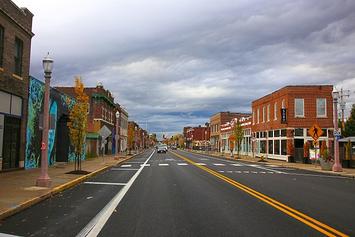
After two painful recessions and ever greater national discord, there is considerable support for a new beginning, even if it takes massive federal spending. The question we must ask now is what kind of spending makes sense given the character of the country, its geography, and its economic challenges. America remains a vast and diverse place, and decisions that make sense for one locale do not necessarily make any sense in others. A dispersed country needs dispersed decision-making, not edicts issued from on high by the D.C. nomenklatura.
His policies seem designed for coastal enclaves that do not represent most of the country.
Unfortunately, Joe Biden’s ballyhooed “infrastructure” plan, coupled with unprecedented stimulus spending, is cast by the obliging media as being about the middle class but seems oddly detached from how the overwhelming majority of the middle class lives, which is in lower-density, automobile-dependent neighborhoods. This dynamic was intensifying even before the pandemic. But Biden’s plan seems mostly about serving the relatively small sliver of transit-riding apartment dwellers living in denser neighborhoods. Overall, dense residential areas accommodate no more than 10 percent of the nation’s population.
Rather than emulate Roosevelt’s New Deal, as Biden’s handlers insist, the plan renounces much of what drove it. The New Deal, whatever one thinks of it, was about improving the material quality of life for most Americans, such as by spreading the benefits of homeownership to an ever-broader part of the population. In contrast, the Biden plan focuses on permanent redistribution through ever more entitlements and dependency — something Roosevelt opposed. It is likely to reduce our competitiveness by boosting energy and regulatory costs as well as taxes.
Perhaps nothing better illustrates the Biden administration’s myopic sense of geography than its transportation priorities. Take urban transit. Biden has proposed a policy that, by some estimates, would allocate $165 billion for public transit (including urban rail — subways, light rail, and commuter rail) against only $115 billion to fix and modernize roads and bridges. Transit, which accounts for about 1 percent of overall urban and rural ground transportation, would receive nearly 60 percent of the money.
Echoing conventional progressive rhetoric, the administration’s transportation secretary, Pete Buttigieg, embraces the idea of getting Americans out of their cars and into trains and buses. For at least half a century, this has been a principal public-policy objective — and the results have been spectacularly unsuccessful. Despite the expenditure of more than $2 trillion and the construction of many new rail systems, transit’s share of daily commute trips dropped 44 percent from 1970 to 2019 (8.9 percent to 5.0 percent of the total). Even before COVID, working at home accounted for more commuting nationwide than did transit. Outside New York City, nearly 60 percent more people worked at home than rode transit in 2019, according to the American Community Survey. Transit accounted for less than 2 percent of all urban travel before COVID. The administration nonetheless is thinking about taxing vehicle mileage to pay for infrastructure, something that would be wildly unpopular outside the handful of dense urban cores where transit ridership is high.
Transit thrives in only a few municipalities (not entire metro areas) with extensive downtown-oriented urban rail systems such as New York, Chicago, Philadelphia, San Francisco, Boston, and Washington. These municipalities, with the nation’s largest downtowns, accommodate nearly 60 percent of transit work-trip destinations but only about 6 percent of the country’s jobs. New York City by itself accounts for 36 percent.
Attempts to boost transit’s share of urban travel have been plagued by a basic problem: In the nation’s major metropolitan areas (those with a population over 1 million), cars can reach almost 55 times as many potential jobs as transit in less than 30 minutes, according to University of Minnesota research. In the New York metro, with by far the largest transit system in the nation, cars can reach six times as many jobs as transit. But demand for both forms of commuting may be lower now, as the pandemic has seen millions of people working at home grow used to a commute time of zero.
Read the rest of this piece at National Review.
Joel Kotkin is the author of The Coming of Neo-Feudalism: A Warning to the Global Middle Class. He is the Presidential Fellow in Urban Futures at Chapman University and Executive Director for Urban Reform Institute. Learn more at joelkotkin.com and follow him on Twitter @joelkotkin.
Wendell Cox is principal of Demographia, an international public policy firm located in the St. Louis metropolitan area. He is a founding senior fellow at the Urban Reform Institute, Houston, a Senior Fellow with the Frontier Centre for Public Policy in Winnipeg and a member of the Advisory Board of the Center for Demographics and Policy at Chapman University in Orange, California. He has served as a visiting professor at the Conservatoire National des Arts et Metiers in Paris. His principal interests are economics, poverty alleviation, demographics, urban policy and transport. He is co-author of the annual Demographia International Housing Affordability Survey and author of Demographia World Urban Areas.
Photo credit: Paul Sableman via Flickr under CC 2.0 License.












